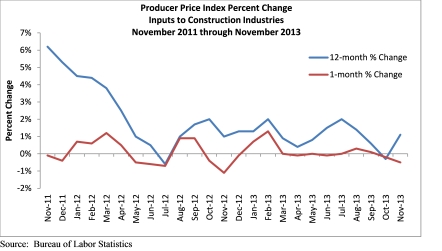Overall, construction materials prices fell 0.5 percent in November and are up only 1.1 percent year over year, according to the Department of Labor’s Dec. 13 Producer Price Index. Nonresidential construction materials are down 0.6 percent for the month and are 0.7 percent lower than the same time last year.
“November represented another month of remarkable stability for construction input prices,” said Associated Builders and Contractors (ABC) Chief Economist Anirban Basu. “Although many investors predicted significant inflation this year due to expansionary monetary policies in much of the developed world, there continues to be a lack of significant inflationary pressures both globally and nationally.”
Overall, the nation’s wholesale goods prices expanded 0.2 percent in November, but are down 0.9 percent year over year.
“Next year is unlikely to offer as much stability as 2013,” Basu said. “Global economic growth is set to accelerate and the apparent budget deal in Congress should produce greater certainty among businesses, helping improve an already benign national economic forecast. Tension in the Middle East also continues to be a consideration. Together, these factors suggest materials price increases may be at least slightly more rapid in 2014.”
THE FOLLOWING MATERIALS PRICES INCREASED IN NOVEMBER:
- Fabricated structural metal products were up 0.1 percent for the month and 0.3 percent year over year.
- Softwood lumber prices increased 2.6 percent on a monthly basis and are up 12.8 percent year over year.
- Natural gas prices were up 1.9 percent for the month and 3.3 percent on an annual basis.
- Nonferrous wire and cable prices rose 0.2 percent on a monthly basis and are down 3 percent year over year.
- Iron and steel prices were up 1.8 percent for the month and are down 0.1 percent compared to the same time last year.
- Prices for plumbing fixtures and fittings inched up 0.1 percent in November and are up 1.6 percent year over year.
- Steel mill products prices increased 0.8 percent in November but are down 0.6 percent compared to the same time last year.
THE FOLLOWING CONSTRUCTION INPUTS EXPERIENCED PRICE DECREASES IN NOVEMBER:
- Prepared asphalt, tar roofing and siding prices were down 3.8 percent for the month and 0.3 percent year over year.
- Crude petroleum prices fell 10.3 percent on a monthly basis but are up 0.9 percent year over year.
- Crude energy prices decreased 5.7 percent in November but are up 0.6 percent compared to the same time last year.
- Concrete products prices were flat in November and are up 2.8 percent year over year.
Related Stories
Cultural Facilities | Mar 26, 2024
Renovation restores century-old Brooklyn Paramount Theater to its original use
The renovation of the iconic Brooklyn Paramount Theater restored the building to its original purpose as a movie theater and music performance venue. Long Island University had acquired the venue in the 1960s and repurposed it as the school’s basketball court.
Adaptive Reuse | Mar 26, 2024
Adaptive Reuse Scorecard released to help developers assess project viability
Lamar Johnson Collaborative announced the debut of the firm’s Adaptive Reuse Scorecard, a proprietary methodology to quickly analyze the viability of converting buildings to other uses.
Security and Life Safety | Mar 26, 2024
Safeguarding our schools: Strategies to protect students and keep campuses safe
HMC Architects' PreK-12 Principal in Charge, Sherry Sajadpour, shares insights from school security experts and advisors on PreK-12 design strategies.
Green | Mar 25, 2024
Zero-carbon multifamily development designed for transactive energy
Living EmPower House, which is set to be the first zero-carbon, replicable, and equitable multifamily development designed for transactive energy, recently was awarded a $9 million Next EPIC Grant Construction Loan from the State of California.
Museums | Mar 25, 2024
Chrysler Museum of Art’s newly expanded Perry Glass Studio will display the art of glassmaking
In Norfolk, Va., the Chrysler Museum of Art’s Perry Glass Studio, an educational facility for glassmaking, will open a new addition in May. That will be followed by a renovation of the existing building scheduled for completion in December.
Sustainability | Mar 21, 2024
World’s first TRUE-certified building project completed in California
GENESIS Marina, an expansive laboratory and office campus in Brisbane, Calif., is the world’s first Total Resource Use and Efficiency (TRUE)-certified construction endeavor. The certification recognizes projects that achieve outstanding levels of resource efficiency through waste reduction, reuse, and recycling practices.
Office Buildings | Mar 21, 2024
Corporate carbon reduction pledges will have big impact on office market
Corporate carbon reduction commitments will have a significant impact on office leasing over the next few years. Businesses that have pledged to reduce their organization’s impact on climate change must ensure their next lease allows them to show material progress on their goals, according to a report by JLL.
Adaptive Reuse | Mar 21, 2024
Massachusetts launches program to spur office-to-residential conversions statewide
Massachusetts Gov. Maura Healey recently launched a program to help cities across the state identify underused office buildings that are best suited for residential conversions.
Legislation | Mar 21, 2024
Bill would mandate solar panels on public buildings in New York City
A recently introduced bill in the New York City Council would mandate solar panel installations on the roofs of all city-owned buildings. The legislation would require 100 MW of solar photovoltaic systems be installed on public buildings by the end of 2025.


















